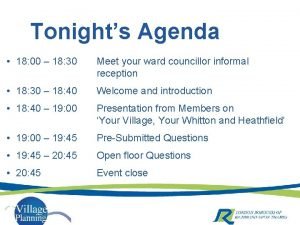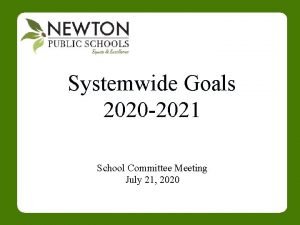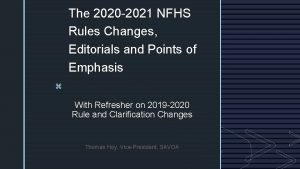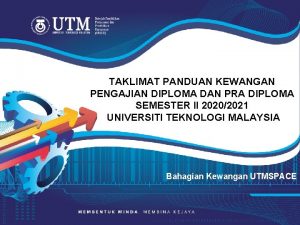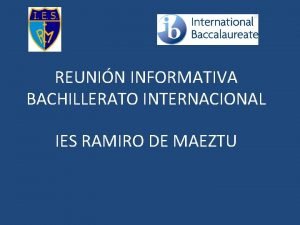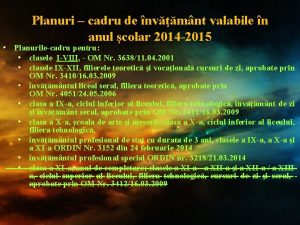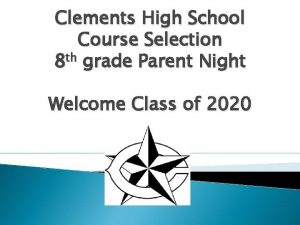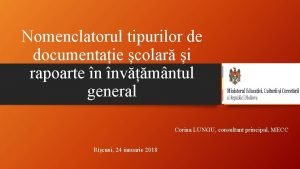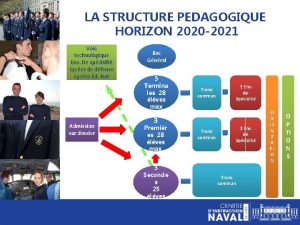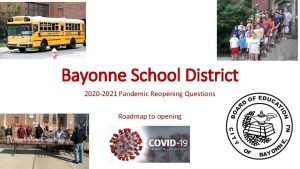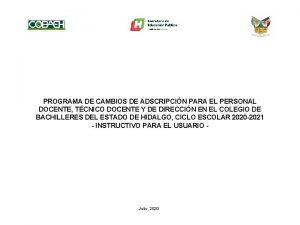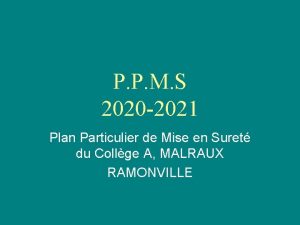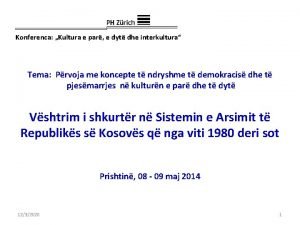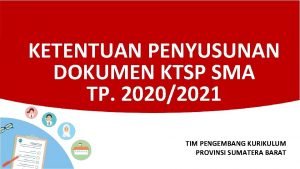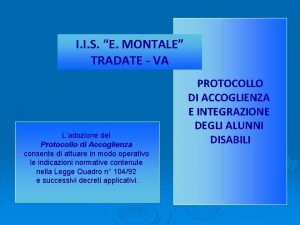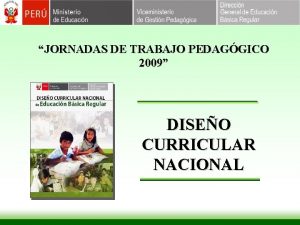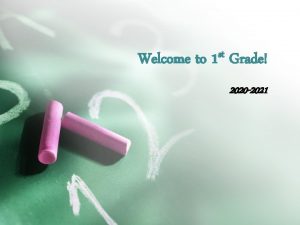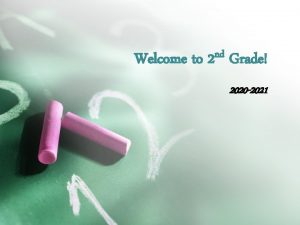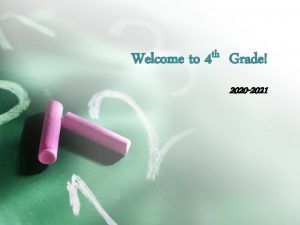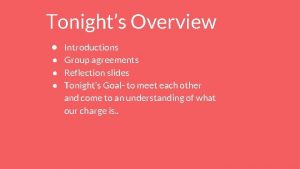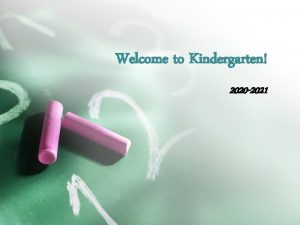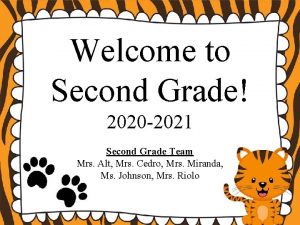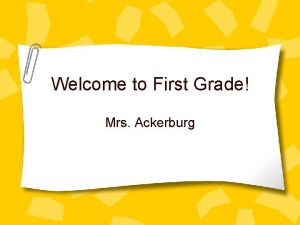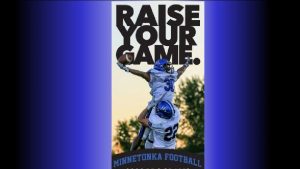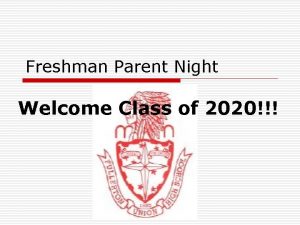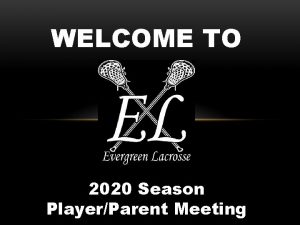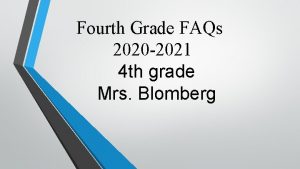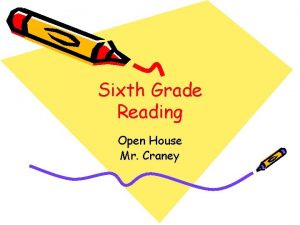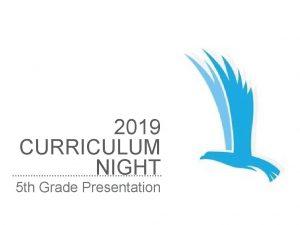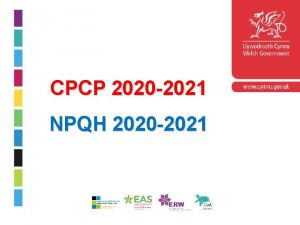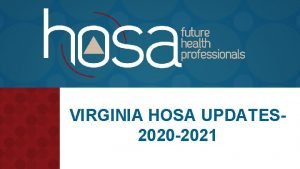Welcome to 1 st Grade 2020 2021 Tonights


















- Slides: 18

Welcome to 1 st Grade! 2020 -2021

Tonight's Agenda (items to be discussed) • Standards • Curriculum • District Assessments – RI/MI/DIBELS • Classroom Assessments • Grading • Goal Setting • Reading Resources • Tech Tips • Copyright Resources • Contact Information

Grade Level Standards • All lessons adhere to GA Standards of Excellence for all subjects • Math – Ø Unit 1 Ø Unit 2 Ø Unit 3 Ø Unit 4 Ø Unit 5 Ø Unit 6 • ELA - https: //www. georgiastandards. org/Georgia. Standards/Frameworks/ELA-Grade-1 Developmental-Progressions-R-W-SL-L. pdf

Curriculum Reading– Bookworms Reading – Shared, Interactive, DI Writing First Grade Rubrics for Narrative, Opinion, and Informational Math – First Grade Number Talks Brochure Math Workshop

i. Read • Meets the students where they are in their instructional literacy level. • Students log on during DI.

District Assessments – • The Reading Inventory is a low-stakes, classroom-based assessment designed to evaluate students’ reading ability, monitor their reading progress, and match students to books at their reading level. • The Reading Inventory is taken on a computer and lasts about 20 minutes. The types of questions a student receives and the results that are reported are based upon the student’s grade level and reading level. • Test Administration – 4 times a year (August, October, January, May)

District Assessments – • The Math Inventory is a computerized test that results in a score, or Quantile® , that indicates how well a student understands mathematical skills and concepts along a developmental continuum. A student who scores at the Proficient level by the end of the school year is considered to be performing on grade level and is on track to meet the demands of college and career by the end of high school. • Test Administration – 3 times a year (August, December/January, May)

District Assessments – • Fluency is defined as the ability to read with speed, accuracy, and proper expression. In order to understand what they read, children must be able to read fluently whether they are reading aloud or silently. When reading aloud, fluent readers read in phrases and add intonation appropriately. • Reading fluency is calculated by taking the total number of words read in one minute and subtracting the number of errors. Grade Level 1 2 3 4 First 0 -31 32 -46 47 -66 67+ Second 0 -64 65 -86 87 -103 104+ Third 0 -79 80 -99 100 -117 118+ Fourth 0 -94 95 -114 115 -132 133+ 0 -104 105 -129 130 -142 143+ Fifth

Classroom Assessments • Edited by Teachers

Grading Scale • Grades are on a 1 -4 scale. 4 Exceeds Mastery: Student applies the skill or concept independently and correctly; communicates higher level thinking or skill level significantly above grading term expectation. This score is a Satisfactory score. 3 Demonstrates Mastery: Student applies the skill or concept independently and correctly; communicates clear understanding at grading term expectation. This is a Satisfactory Score. 2 Progressing Towards Mastery: Student applies the skill or concept with support/not independently; communicates some understanding but is not currently meeting grading term expectation. This is an Unsatisfactory score. 1 Limited or Minimum Progress: Student has limited ability to apply the skill or concept, even with support; communicates limited understanding and is not currently meeting grade term expectations. Progress Reports Issued: Report Cards Issued: November 13 th – 2 nd 9 weeks March 19 th – 3 rd 9 weeks June 2 nd – 4 th 9 weeks October 16 th – 1 st 9 weeks January 5 th – 2 nd 9 weeks March 19 th – 3 rd 9 weeks June 2 nd – 4 th 9 weeks

Goal Setting • G - Growth Leverage parent support: If we want students (especially • O - Ownership our youngest ones) to set • A - Awareness goals that have any personal meaning, those goals need • L - Learning to be transferrable from school to home. In this sense, parents are a key “Setting goals is the first step player. Goals that are in turning the invisible into meaningful for both students the visible. ” and parents are key in -Tony Robbins fostering long-term growth. -Journal of Research in Childhood Education

Grade Level Goal Know all 200 sight words and read on grade level at 60 words correct per minute with a minimum 88% accuracy. WAYS TO ASSIST AT HOME • Focus on five to ten sight words each night with your student. Ø Set a timer for your students to see if they can “beat the timer”. Ø Create flashcards of the high frequency words your students do not know. Ø BAM! -

Reading Resources • Raz. Kids - https: //www. raz-kids. com/ Ø Online practice on literacy standards and skills Ø Teacher login: Contact Teacher Ø Student login: Lunch number • Education Galaxy – www. educationgalaxy. com Ø Students can practice Reading Standards in an engaging online setting. Ø Student login – Student ID # + hes (i. e. 123456 hes) Ø Student Password – Student ID # (i. e. 123456)

Tech Tips –Online Learning

Tech Tips – cont’d • Canvas Student Login – Ø Student login - Student ID # @paulding. k 12. ga. us • (i. e. 12345@paulding. k 12. ga. us) Ø Student Password – first initial + middle initial + last initial and 4 digit birthday (month and day) • (i. e. abc 0102) • Canvas Parent Help Guides - https: //community. canvaslms. com/t 5/Observer-Guide/tkbp/observer • Information for Digital Learning Days – short term and/or long term (pivot) - https: //www. paulding. k 12. ga. us/Page/42513

What is Copyright? Did you know that whenever you write a poem or story or even a paper for your class, or a drawing or other artwork, you automatically own the copyright to it. Copyright is a form of protection given to the authors or creators of "original works of authorship, " including literary, dramatic, musical, artistic and other intellectual works. What that means is that, as the author of the work, you alone have the right to do any of the following or to let others do any of the following: - make copies of your work; - distribute copies of your work; - perform your work publicly (such as for plays, film, dances or music); - display your work publicly (such as for artwork, or stills from audiovisual works, or any material used on the Internet or television); and - make “derivative works” (including making modifications, adaptations or other new uses of a work, or translating the work to another media). In general, it is illegal for anyone to do any of the things listed above with a work created by you without your permission, but there are some exceptions and limitations to your rights as a copyright holder. One major limitation is the doctrine of “Fair Use”. Student Guide for more information on copyright - http: //www. copyrightkids. org/cbasicsframes. htm Parent Guidance for more information on copyright - https: //parentingdigital. com/parents-guide-copyright-fair-use/

Contact Information Feel free to reach out to your child’s teacher with questions. Email or Class Dojo: Mary Cameron mcameron@paulding. k 12. ga. us Nina Benoit nbenoit@paulding. k 12. ga. us Tonya Chastain tchastain@paulding. k 12. ga. us Meagan Fugua mfuqua@paulding. k 12. ga. us Meagyn Wilkie mwilkie@paulding. k 12. ga. us You may also contact our Instructional Lead Teacher: Courtney Osley cosley@paulding. k 12. ga. us

 Tonights agenda
Tonights agenda Wise men three clever are we
Wise men three clever are we Welcome to new session 2020-21
Welcome to new session 2020-21 Teacher goals for 2020-2021
Teacher goals for 2020-2021 Nfhs volleyball uniform rules 2020-2021
Nfhs volleyball uniform rules 2020-2021 Pra diploma utm
Pra diploma utm Ies ramiro maeztu
Ies ramiro maeztu Edu.ro programe scolare 2020-2021
Edu.ro programe scolare 2020-2021 Clements high school courses
Clements high school courses Nomenclatorul educatorului
Nomenclatorul educatorului Horizon 2020 2021
Horizon 2020 2021 Bayonne school calendar 2020-2021
Bayonne school calendar 2020-2021 Convocatoria cobaeh 2020
Convocatoria cobaeh 2020 Ppms 2020 2021
Ppms 2020 2021 Masht planprogramet 2020
Masht planprogramet 2020 Dokumen 1 ktsp sma tahun 20202021
Dokumen 1 ktsp sma tahun 20202021 Istituto eugenio montale tradate
Istituto eugenio montale tradate Xxxx 2020 2021
Xxxx 2020 2021 Textos de lengua materna
Textos de lengua materna
